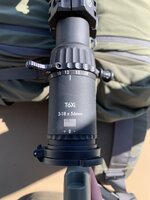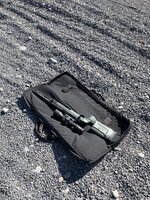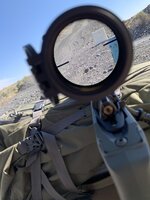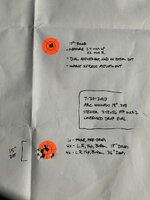alpine_troop
Lil-Rokslider
- Joined
- Nov 3, 2021
- Messages
- 217
Today I was at the range playing musical scopes on rifles, getting things zeroed. After spreading the good word to all my shooting friends who will listen about the RS drop tests, I decided it’s high time to put my money where my mouth is and actually test one of my setups. @Basin_Bastard was present to witness.
Test rifle is my American Rifle Company Nucleus 2.0 with 18” .308 Win CarbonSix barrel, TriggerTech, KRG Bravo. Ammo was factory Hornady 155 gr ELDM. The scope was zeroed and the zero group was consistent with what this rifle always does: all rounds within a 1.5” dot at 100 yards (no I didn’t take a picture of the zero group, sorry).
Scope tested is my Steiner T6xi 3-18x56 with the MSR2 reticle. I purchased this scope earlier this year to go on a different rifle. It has less than 200 rounds on it at the time of this eval. Scope was mounted in an ARC MBrace 1.5” single piece mount. Therefore the total setup is roughly 8.25 lbs of rifle with another 3 lbs of scope and mount on top. Full specs for the Steiner are readily available online, no need for me to take up space here. It’s heavy, in fact the whole T6xi series is heavy, but they are feature-rich tactical scopes and probably not a first choice for hunting. This was mostly an eval for my curiosity and data.
Evaluation process:
Target at 100 yards with two 1.5” dots. Shot off my pack with a rear bag at 12x magnification. I fired one round into the bottom dot prior to any drops. Then I commenced with the drops on a 1/2” padded mat (open gun case) on gravel. A shot was fired into the bottom dot after each drop.
18” drops: left, right, top, bottom (4 drops & shots)
36” drops: left, right, top, bottom (4 drops & shots)
For the last shot, I used the reticle to measure from the bottom dot to the top dot, dialed the correction (2.4 mils up/ 0.2 mils right), aimed at the bottom dot, and fired. As you can see, following the drops, the Steiner correctly adjusted and the round impacted the center of the top dot.




Looks pretty good to me. Now, this is just a condensed eval and I realized after that I deviated from the standard eval format a bit. I will likely repeat this to the standard and monitor over time. That will include a 30 round zero proof group documented so I know I’m not seeing small deviations after drops. But for now, seeing as the wheels didn’t fall off after 4x 18” and 4x 36” drops, I’m happy with it.
If folks would like my subjective opinions on the scope overall, I can follow-up with that too. As I have no field use with the scope and reticle yet, I figured it best to reserve opinions. Since it passed a preliminary drop eval, I plan to get some lower MBrace rings for it and take it elk hunting this season.
Test rifle is my American Rifle Company Nucleus 2.0 with 18” .308 Win CarbonSix barrel, TriggerTech, KRG Bravo. Ammo was factory Hornady 155 gr ELDM. The scope was zeroed and the zero group was consistent with what this rifle always does: all rounds within a 1.5” dot at 100 yards (no I didn’t take a picture of the zero group, sorry).
Scope tested is my Steiner T6xi 3-18x56 with the MSR2 reticle. I purchased this scope earlier this year to go on a different rifle. It has less than 200 rounds on it at the time of this eval. Scope was mounted in an ARC MBrace 1.5” single piece mount. Therefore the total setup is roughly 8.25 lbs of rifle with another 3 lbs of scope and mount on top. Full specs for the Steiner are readily available online, no need for me to take up space here. It’s heavy, in fact the whole T6xi series is heavy, but they are feature-rich tactical scopes and probably not a first choice for hunting. This was mostly an eval for my curiosity and data.
Evaluation process:
Target at 100 yards with two 1.5” dots. Shot off my pack with a rear bag at 12x magnification. I fired one round into the bottom dot prior to any drops. Then I commenced with the drops on a 1/2” padded mat (open gun case) on gravel. A shot was fired into the bottom dot after each drop.
18” drops: left, right, top, bottom (4 drops & shots)
36” drops: left, right, top, bottom (4 drops & shots)
For the last shot, I used the reticle to measure from the bottom dot to the top dot, dialed the correction (2.4 mils up/ 0.2 mils right), aimed at the bottom dot, and fired. As you can see, following the drops, the Steiner correctly adjusted and the round impacted the center of the top dot.




Looks pretty good to me. Now, this is just a condensed eval and I realized after that I deviated from the standard eval format a bit. I will likely repeat this to the standard and monitor over time. That will include a 30 round zero proof group documented so I know I’m not seeing small deviations after drops. But for now, seeing as the wheels didn’t fall off after 4x 18” and 4x 36” drops, I’m happy with it.
If folks would like my subjective opinions on the scope overall, I can follow-up with that too. As I have no field use with the scope and reticle yet, I figured it best to reserve opinions. Since it passed a preliminary drop eval, I plan to get some lower MBrace rings for it and take it elk hunting this season.
Last edited:

